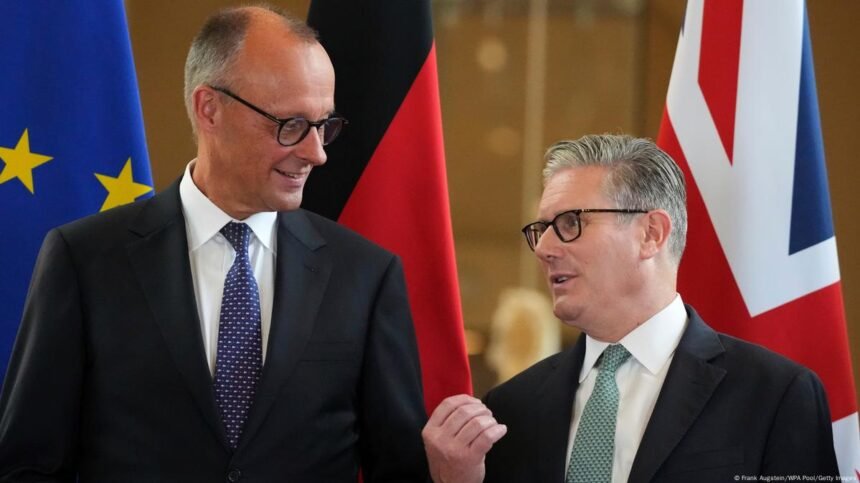London, July 19, 2025 — In a landmark diplomatic move, UK Prime Minister Keir Starmer and German Chancellor Friedrich Merz signed the Kensington Treaty on July 17 in a ceremony at London’s Victoria & Albert Museum. This bilateral pact—formally titled the “Friendship and Bilateral Cooperation Treaty”—marks a strategic deepening of ties between two of Europe’s most influential powers.
Why the Treaty Matters
As global tensions rise—from the war in Ukraine to evolving tech competition—the Kensington Treaty strengthens:
- Defence collaboration: Joint research into next-gen defense systems and cyber security.
- Technology cooperation: Shared standards and innovation in AI, semiconductors, and defense tech.
- Geopolitical coordination: A unified approach to the Russo-Ukrainian conflict and EU strategic policy.
Starmer and Merz acknowledged that this treaty places both nations on a shared path toward enhanced stability, resilience, and global leadership.
Core Themes of the Kensington Treaty
1. Strengthening Defense and Security
The treaty creates a joint UK-Germany working group on defense innovation. This group will focus on:
- Advanced cyber defence systems
- Co-development of surveillance drones and semi-autonomous naval craft
- Shared military exercises to build interoperability
2. Technology & Industrial Partnerships
The agreement underscores cooperation on cutting-edge technologies, such as:
- AI & machine learning in defense applications
- Joint semiconductor supply chain initiatives to reduce global reliance
- Collaborative research & development in secure communication tech
3. Syncing on Ukraine Strategy
Both leaders affirmed aligned approaches toward supporting Ukraine, including:
- Shared intelligence cooperation
- Coordinated non-lethal aid
- Joint sanctions policy to pressure Russia
4. Economic & Cultural Engagement
Beyond hard power, the treaty also focuses on:
- Tech, infrastructure, and green-energy investments
- Academic and cultural exchanges boosting unity
- Streamlined visa and mobility arrangements for professionals
European & Global Context
This treaty is significant amid shifting geostrategic dynamics:
- Russia’s war in Ukraine remains unpredictable, demanding a unified Western response.
- Sino-American tech rivalry pressures Europe to develop resilient supply chains.
- UK-EU relations post-Brexit continue to evolve; closer ties with Germany signal trust and partnership.
By aligning with Germany, the UK positions itself as a co-leader in Europe—committed to democratic values, defense readiness, and tech sovereignty.
Leaders’ Reflections
At the Kensington Treaty Museum signing:
- Starmer remarked: “This treaty is a signal to our people and to the world—Britain stands with Germany in securing our future.”
- Merz added: “Our collaboration is rooted in history, common values, and a shared destiny. We will rebuild Europe’s strategic autonomy.”
Both leaders highlighted the treaty as a stepping stone toward deeper alliances across defense, industry, and knowledge sectors.
Road to Implementation
The treaty outlines concrete steps:
- June 2026: Defence R&D group begins operations
- September 2025: Two joint AI pilot projects launched
- Early 2026: Semiconductor task-force finalizes supply-chain plan
- Throughout 2026: UK-funded internships expand to Germany and vice versa
Both governments intend to make swift progress on binding memorandums of understanding.
What This Means for Citizens
- UK and German tech workers may benefit from easier exchange programmes and visa arrangements.
- Defense industries in both countries can access new pools of talent and investments.
- Ukraine policy aims for coordinated support mechanisms, increasing aid effectiveness.
- Startup ecosystems could see new UK–Germany bilateral funding opportunities.
The treaty’s ripple effect could create fresh jobs, innovation projects, and citizen mobility across borders.
Challenges & Watch-Outs
- Parliamentary approval: UK Parliament debates treaty terms in the autumn; German Bundestag vote follows.
- EU norms: Germany must ensure deeper UK ties respect EU standards post-Brexit.
- Budget pressures: Shared R&D initiatives require funding during global fiscal uncertainty.
- Public sentiment: Voters on both sides await clear benefits from this strategic push.
Execution speed and public confidence will shape the treaty’s real impact.
What Comes Next
- July 30: Joint press conference to detail defense collaboration plans
- September: AI research teams operational in London and Berlin
- October: First cultural-exchange programme begins between UK and German universities
- Early 2026: Challenge Round 1 of semiconductor task force closing stages
These milestones will test the treaty’s promise and resilience.
The Kensington Treaty is a powerful signal that the UK and Germany are not just long-time allies—they’re deepening cooperation to meet modern challenges. Whether in defense, digital sovereignty, or security, this initiative could shape Europe’s strategic posture for decades.
But turning words into action—and forging public trust—will determine if this treaty becomes a true blueprint for 21st-century partnership.
Watch for developments later this year: the treaty’s success may hinge less on ambition, and more on implementation.
Kensington Treaty Signed, Kensington Treaty, Kensington Treaty Signed
“Exciting News! Sejal News Network is now on WhatsApp Channels
Subscribe today by clicking the link and stay updated with the latest news!” Click Here
Our App : Click Here
📰 Latest from Sejal News Network
- Medicine Planet Strengthens Pharmaceutical Exports from India to Global Markets
- Anil Kaarakkulam’s ‘INI - The Unknown Tomorrow’ Raises a Strong Voice Against Drugs and Child Exploitation Through the Eyes of a 13-Year-Old
- Daily Horoscope for 7 Jan 2026 — Wednesday
Published by Sejal News Network


